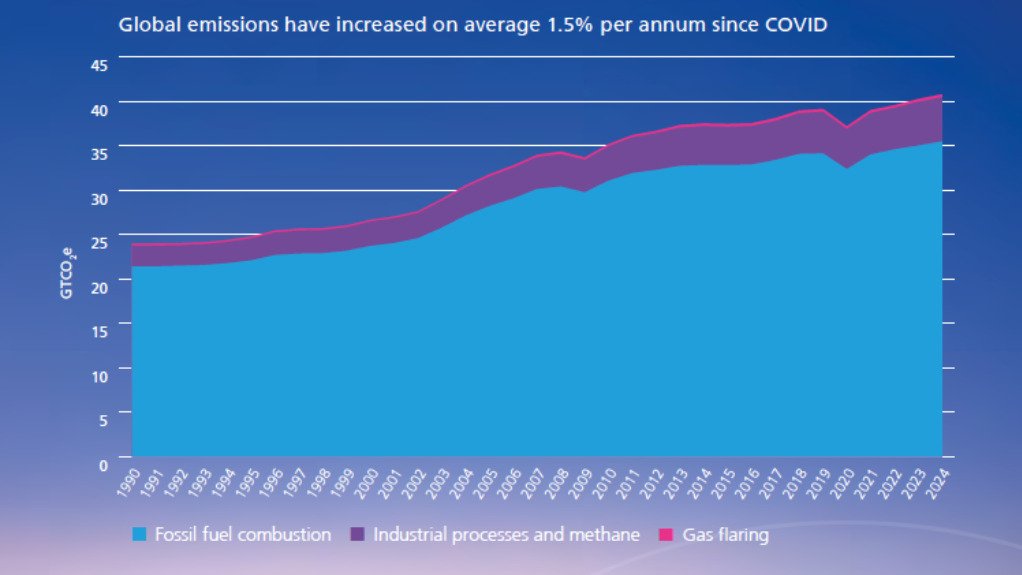Statistical review highlights scale of energy transition challenge as emissions continue to rise
Global emissions from energy grew 1% to a record 40.8 Gt of carbon dioxide equivalent (CO2e) in 2024 as total energy demand rose 2% to a new high of 592 exajoules (EJ), the latest ‘Statistical Review of World Energy’ shows.
Produced for the second time by the Energy Institute, in collaboration with Kearney and KPMG, the review marked its seventy-fourth edition, having been produced until 2023 by energy group BP.
The report noted that it was the fourth consecutive year of record CO2e emissions from the energy sector, which came amid extreme weather events across the world and with global average air temperatures having regularly exceeded 1.5 °C above the pre-industrial age.
Energy Institute CEO Dr Nick Wayth said that, for the first time since 2006, all energy sources reached record production levels, including coal, hydro, oil, gas, nuclear and renewables.
Renewables also remained the fastest growing energy source with a 7.6% increase in energy supplied, with record solar PV additions recorded, growing by nearly 28% and adding 455 TWh during 2024.
“In fact, solar alone added 50% more than coal and gas additions in power combined,” Wayth said.
The report also underlined the rise of electricity over other energy sources, with global electricity generation having grown on average around 2.6% yearly over the past ten years, which was about twice the rate of total energy demand.
In 2024, electricity demand grew by 4%, which the report described as an indicator that the world’s energy system continued to electrify.
In addition, since 2010 the world had avoided using 1 371 EJ of fossil fuels and emitting 110 Gt of greenhouse gases through renewables and nuclear.
Nevertheless, Wayth also argued that the statistics pointed to a “disorderly” transition rather than a “clean handover from fossil fuels to renewables”.
“The energy transition is progressing, but unevenly – some regions are cutting fossil use, others are expanding it.”
Wayth described China as a particular “paradox”, owing to its position as the world’s biggest driver of renewables growth and its largest source of emissions.
Over the past decade China had nearly doubled its electricity supply, adding 405 TWh more than Europe’s entire 2024 electricity generation, and last year, excluding hydro, China was responsible for nearly 60% of total global renewable power supply additions. Nevertheless, coal continued to dominate China’s electricity sector, generating 58% of its output in 2024, while the country accounted for around a third of global emissions.
RISE OF ELECTRICITY
However, Energy Institute president Andy Brown said the statistics also pointed to several positive developments, especially in relation to the rising role of electricity, which was underpinned by the growth in renewables.
“To get to the future, we have to decarbonise our electricity system, and we have to electrify everything we can.
“Therefore, the 4% increase in electricity is a very good result, and 53% of that increase comes from renewable sources – so we can take real comfort from that,” Brown said.
Likewise, he argued that developments in China were promising, especially the rapid rise of electricity demand, which was being met overwhelmingly by solar PV, hydro and wind.
“China is the most electrified energy system of any advanced economy in the world, and it's growing fast, and it's doing it now predominantly with low-carbon additions.
“It's still 58% coal in power generation, but it was 70%.
“So, what we can see is China is starting to decarbonise its electricity system, while growing the role of electricity in the energy system.
“This is a model of the future of energy transition,” Brown argued.
Worryingly the statistics show that growth in energy demand in Africa continued to lag the rest of the world.
“For the nearly 1.5-billion people who have the least access to energy, total energy demand only increased by 1% … increasing the gap between Africa and India,” Wayth said.
“The lack of access to energy across the continent of Africa remains a global failure. Accelerating deployment of energy infrastructure there remains an urgent priority.”
Article Enquiry
Email Article
Save Article
Feedback
To advertise email advertising@creamermedia.co.za or click here
Comments
Press Office
Announcements
What's On
Subscribe to improve your user experience...
Option 1 (equivalent of R125 a month):
Receive a weekly copy of Creamer Media's Engineering News & Mining Weekly magazine
(print copy for those in South Africa and e-magazine for those outside of South Africa)
Receive daily email newsletters
Access to full search results
Access archive of magazine back copies
Access to Projects in Progress
Access to ONE Research Report of your choice in PDF format
Option 2 (equivalent of R375 a month):
All benefits from Option 1
PLUS
Access to Creamer Media's Research Channel Africa for ALL Research Reports, in PDF format, on various industrial and mining sectors
including Electricity; Water; Energy Transition; Hydrogen; Roads, Rail and Ports; Coal; Gold; Platinum; Battery Metals; etc.
Already a subscriber?
Forgotten your password?
Receive weekly copy of Creamer Media's Engineering News & Mining Weekly magazine (print copy for those in South Africa and e-magazine for those outside of South Africa)
➕
Recieve daily email newsletters
➕
Access to full search results
➕
Access archive of magazine back copies
➕
Access to Projects in Progress
➕
Access to ONE Research Report of your choice in PDF format
RESEARCH CHANNEL AFRICA
R4500 (equivalent of R375 a month)
SUBSCRIBEAll benefits from Option 1
➕
Access to Creamer Media's Research Channel Africa for ALL Research Reports on various industrial and mining sectors, in PDF format, including on:
Electricity
➕
Water
➕
Energy Transition
➕
Hydrogen
➕
Roads, Rail and Ports
➕
Coal
➕
Gold
➕
Platinum
➕
Battery Metals
➕
etc.
Receive all benefits from Option 1 or Option 2 delivered to numerous people at your company
➕
Multiple User names and Passwords for simultaneous log-ins
➕
Intranet integration access to all in your organisation




















